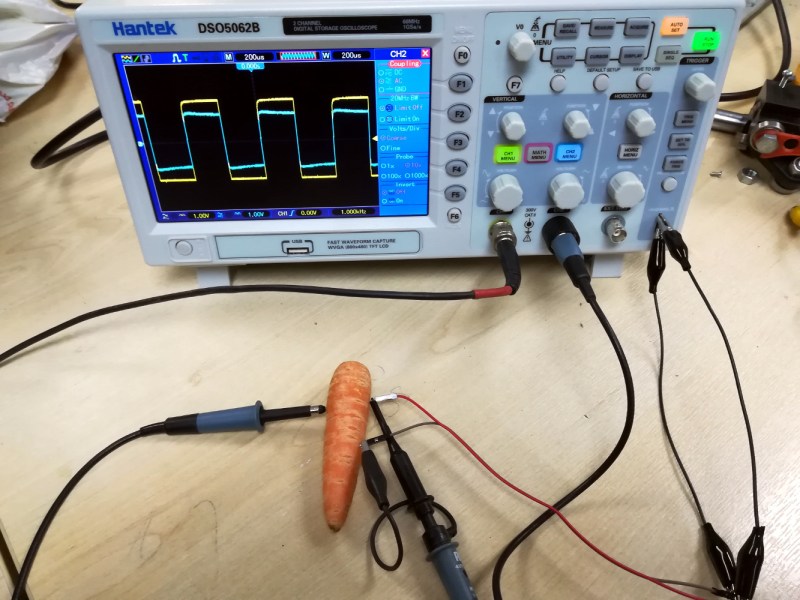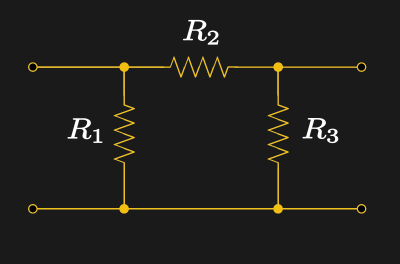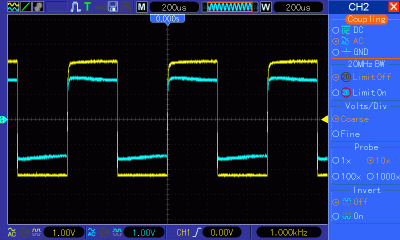![[Boltz999]'s carrot interconnect.](https://hackaday.com/wp-content/uploads/2019/12/carrot-interconnect.jpg?w=400)
Does this mean that our gold-nanoparticle-plated oxygen-free directional audio cables are junk, and we should be heading for the supermarket to pick up a bag of root vegetables instead? I set out to test this new material in the secret Hackaday audio lab, located on an anonymous 1970s industrial estate in Milton Keynes, UK.
Characterising A Root Vegetable

A quick search on the composition of a carrot reveals an 88% water content, with the other 12% being mostly carbohydrates, followed by small quantities of fat, protein, and a cocktail of those vitamins and minerals that caused our parents to be so enthusiastic about our younger selves eating them. In particular about 0.4% of a carrot is comprised of potassium, sodium, and calcium ions in solution, making the vegetable analagous to a sponge soaked in a weak electrolyte solution. Thus you’d expect it to be conductive, and to pass a line-level audio signal into a high-impedance load such as an audio amplifier. A quick DC resistance measurement of our test carrot showed a resistance that started at about 50K for distances up to about 10mm, rising slowly to near 100K across its roughly 80mm length. It’s probably beyond the scope of this piece, to characterise the complex impedance of a carrot.

The hack that prompted all this though didn’t simply replace the pair of copper wires with ones made of carrot. By plugging the phono into the tap root an extra 50K resistance is created between its two conductors as well as between it and the other phono, and the result is a resistor network. Because it’s not an unreasonable assumption the two pieces of hi-fi equipment in the same rack could share an earth, rather than disappear down the rabbit hole of infinite meshes of resistors it’s probably safe instead to think of it as something closer to the familiar Pi network attenuator. There are plenty of online calculators that could give you a performance figure for a given network, but in this case with so many approximations and carrot-related guesses their results would be rather meaningless. All that we need to know is that there will be some attenuation of any audio fed into the carrot.
Crisp Treble, and a Crunchy Midrange

Having discussed the theory, it’s time to move onto the practice. Standing in for a high-end audio source was my phone playing YouTube videos, and for a high-end hi-fi a set of amplified computer speakers. Surprisingly it worked, but unsurprisingly in doing so there was a noticeable attenuation that cut the volume by around half. Exactly as expected, but there was a further step of taking a look at it with a ‘scope.
Applying a handy 1kHz squarewave a 30% attenuation was immediately obvious (as well as that maybe the secret lab’s ‘scope probes needed adjusting). We lacked an audio analyser to measure the harmonic distortion of the coupling, but there has to come a point at which characterising a vegetable comes to an end.
So, we’ve proved the original story to be true, you can use a carrot in an audio interconnect. But how would we describe its sound? The answer if you are fond of audiophile reviews is that it adds an organic feel to the broader soundstage, with crisp treble notes, a crunchy midrange, and deep, earthy bass tones. Meanwhile if you are simply looking for something to connect two cables, we’d suggest a carrot sounds better in the roasting pan.
Header image: Sajetpa [CC BY-SA 3.0]
















Is it April 1st already?
April 1st used to be the start of a New Year, when the calendar changed, those that refused to celebrate on January 1st, were called “April Fools”.
It should be, shouldn’t it. :) But the guy using the carrot was real.
Awesome replies!!!!!
Years ago, a friend-of-a-friend did some performance art where they sent CVBS video through a steak, and what happened to that video as the steak was cooked in a griddle.
That… Honestly sounds really awesome. Is this something that can be viewed online?
I think YouTube subscriber-ship could be at stake there…
“It’s probably beyond the scope of this piece, to characterize the complex impedance of a carrot.” … A part of me wants to go hook my LCR meter to a carrot now.
See, if you can obtain purple carrots for testing as well!
Yessss, Purple carrots to listen Purple rain !
Jenny, you’ve ensiled my face for the day, thank’s a lot :OD
I have an 8753 network analyzer that goes up to 6 GHz, but I am unable to find an appropriate launcher. The resistivity is pretty very high, ~50K ohms/sq, so I’d expect low impedance due to the high water content (dielectric constant of 80). You can see the phase shift in that square wave. I tested one of my own DUTs, a Parisian Short organically grown in clay.
Maybe I can put my 8903b Audio Analyzer to use… :D
Yeah… it get’s strange when you want to start collecting spectral and other non-destructive analytical characteristics of everything… at least did with me.
I totally wanted a diffuse reflectance IR, NIR (mainly), Vis and UV database of everything at one point in my life. Then it turned into microwaves on up… then why not DC to Gamma characteristics database?
Interesting how everything technically has electronic and magnetic characteristics… and some other characteristics too.
I only use organic purple Asiatics, unfrozen, for better soundstage, and replace them every 100 hours of listening. Bin them by taper; it must be mostly linear and matched per pair of channels. Replace every 100 hours. Nothing can beet them.
I like your thinking.
That post should have waited until April 1st :-)
But it’s real, April Fools are made up.
That’s the joke.
https://youtu.be/xECUrlnXCqk
Also you can run DSL over wet string:
https://boingboing.net/2017/12/13/rfc-2549.html
No quibble there — this is apparently what Century Link does in my neighborhood.
Wet string would have been an improvement in one neighbourhood I was in, half century old copper, buried in some weird star topology, shortest path, only a foot under everyones yards, connected at a 30’s sub exchange then trunked to main exchange in old downtown. Now there’s supposed to be fines for digging up utilities, but since the phone cables were very unpredictably located and shallow, people were always digging them up, going oh shit and twisting the ends back together themselves instead of reporting them. So every time it rained the phones and DSL went out. The line was rented through my ISP and they had to deal with the Telco, which charged them a fortune per callout, so there was ridiculous amount of hoop jumping, reboot computer, try different browser BS, when you could see damn well the line fault light was blinking on the modem… and this happened about monthly until I gave up and got another service.
LOL!
Coat hanger wire VS Monster Cable. https://www.engadget.com/2008/03/03/audiophiles-cant-tell-the-difference-between-monster-cable-and/
Isn’t anonymous industrial estate and Milton Keynes in the same sentence redundant? :-p
There is a shopping centre too.
And concrete cows. And roundabouts. Lots of roundabouts.
I suggest some capacitors might improve things. Try a few Ps.
Next up in the root vegetable audio space, beets by Dr Dre.
It seems that a root-veggie based audio coupling is the next logical step after ADSL-over-wet-string (https://hackaday.com/2017/12/14/adsl-robustness-verified-by-running-over-wet-string/) which was similarly both extremely silly, and somewhat surprising to see that it worked even as well as it did…
Brilliant piece to vegetate over
Did you ducktape the carrot to a wall at least?
Jenny, that’s audio. Can iI use one of suitable length to replace my broken handheld VHF antenna? Will skin effect be the dominant impedance determinant? Should I also evaluate parsnips to maintain vegetable parity in this market?
It probably won’t be conductive enough at VHF; and they are too short to be a quarter wavelength. They might start to work somewhere in the UHF region and will be more wideband if fed at the bottom end to approximate a bow tie (over a ground plane).
I’d recommend the classic Co-Tanger Antenna, which you can usually find the materials for in the nearest closet. Widely used in automotive retrofit applications, and theft-resistant.
If I recall, trees and other living systems are better resonant at the lower frequencies and in general lower range.
Not sure if there is a correlation with plant electrophysiology… though thinking is. Be a good question for J.C. Bose.